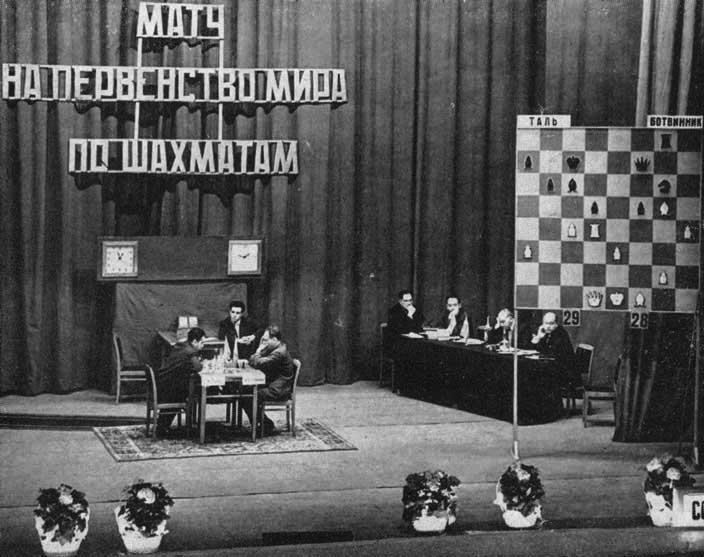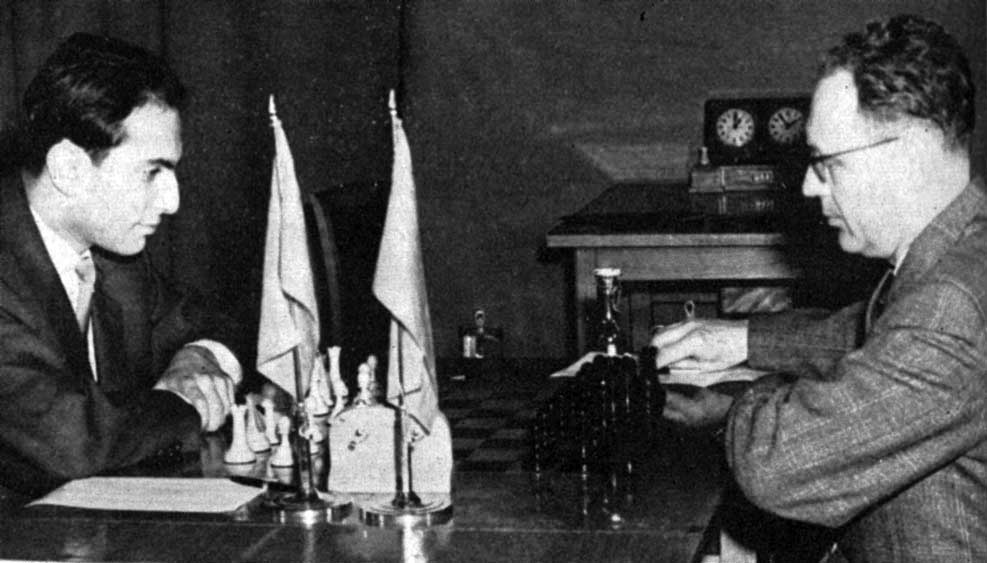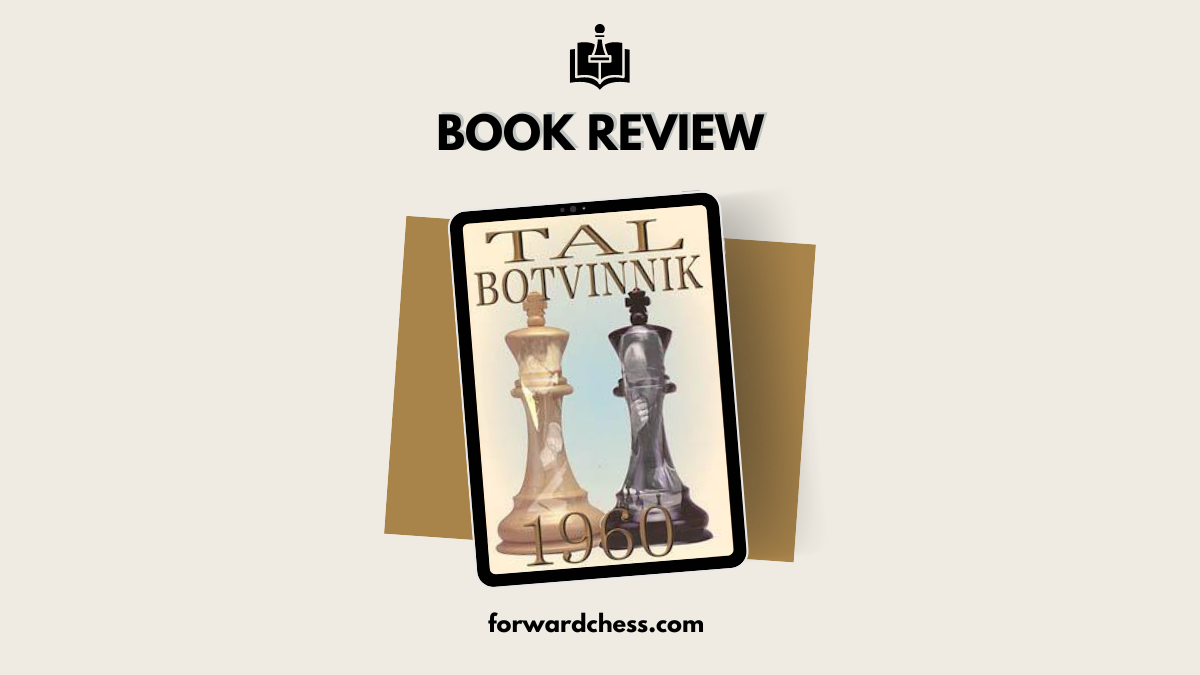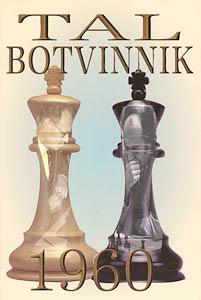A masterful review of the meteoric book Tal Botvinnik (1960) by none other than the magician of Riga himself, Mikhail Tal.
“You must take your opponent into a deep dark forest where 2+2=5, and the path leading out is only wide enough for one.”
~ Mikhail Tal
Mikhail Tal had a meteoric rise in chess that culminated in the match against Mikhail Botvinnik in 1960. His success in that match made him the youngest world champion at the time at just 23 years of age. Unfortunately, this match turned out to be the pinnacle of his career, as he lost the return match against Botvinnik in 1961.
Tal was plagued with serious health issues throughout his career, and he was never able to play a world championship match again after 1961. Despite this, he remained a very strong player with many victories to his credit. While he was mostly known for his daring sacrificial style, he was also capable of playing solidly, and his run of 95 games without defeat in 1973-1974 is testament to this. Of his many sacrifices, he wrote:
“There are two types of sacrifices: correct ones and mine.”
~ Mikhail Tal
Such an approach was very successful in those pre-computer days, where the defender had to solve difficult defensive problems under time constraints. While it is more difficult to play in this style in our current computer-assisted times, such games still bring tremendous joy to chess players, as the games of Garry Kasparov and Alexei Shirov, for example, have shown.
Tal was also a fine writer, and this book, together with his autobiography, are good examples of this. This book provides Tal’s analysis of the 1960 match. At the start of the book, Tal states that his aim is as follows.
“[My] goal was not to discover some move in the struggle through the eyes of a detached spectator, but to try to give the personal feelings, thoughts, agitation, and disappointments of a direct participant in the combat. Let the reader not complain that, in this book, he will not see Tal, figuratively speaking, in a starched white shirt and tie, but in his working clothes; I will relate the story of the match, basically, from the beginning of this intense duel.”

This quote already displays Tal’s writing style in the book. It is very much a personal account with all the highs and lows of the match. All the games are carefully analysed with both analytical variations and text. Of course, it’s important to note that analysis was done without the assistance of super-strong chess engines that are available now. Hence, it’s inevitable that there have corrections and extensions of the analysis over the years, notably by Garry Kasparov and Tibor Károlyi in their biographical books on Tal. Moreover, none of these later discoveries are included in the book, so that it remains an accurate record of what Tal originally wrote. While the inclusion of some of the more recent additions could have been useful, the book is not diminished by this omission.
Tal comes across as honest and very modest in this book. For example, he points out that in contrast to the older Botvinnik, a veteran of four previous world championship matches, he lacked experience in matches:
“Until that time, I had considered myself, and not without reason, among the ranks of tournament chess players – I had only had one occasion to play an actual match (that was in 1954, when I, to tell the truth, really did not imagine that it was necessary to prepare for such a contest). Therefore I was completely unfamiliar with the specific character of this type of competition.”
He freely admits his mistakes both on and off the board in the match, and he compliments Botvinnik frequently for his profound understanding of chess and his vast experience.
Apart from the analysis, a highlight of the book is the inclusion of many insights into off-the-board tactics, such as opening choices, psychological aspects, physical fitness, and when to adjourn games, and of course adjournment analysis. Adjournments were a critical part of chess in those days, and it is fascinating to read about this long-abandoned practice, where again strong chess engines have made adjournments undesirable and obsolete.
It’s notable that opening preparation was not a major component of the pre-match activities, which is a far cry of what happens in top-class chess these days! Tal writes:
“Physical preparation, it seems to me, lies not solely in the realm of chess. But we gave fundamental consideration to physical preparation that would give me better chances of having a fresh mind in such a tiring match, rather than generating two suitcases of theoretical novelties.
However, due to general fatigue, it turned out that I was not in any condition to sharpen any opening edges anyway. Therefore, we did not spend too much time preparing the openings. I, understandably, felt during the match that I could not be satisfied with my results in the initial stages in many games. But there were also advantages – from the outset of the first game, I felt “hungry” for chess, and what is even more important, right to the beginning of the 21st game, I never felt too “full.””
Another fascinating feature of the book is the inclusion of the clock times for all the games. This information show that Botvinnik was invariably behind on the clock, and that his time trouble problems had a major impact in some of the games. For example, Botvinnik spent nearly 20 minutes on his 6th move in game 5, although Tal repaid the complement by thinking for 22 minutes on move 10 of the game, when he considered a piece sacrifice that he eventually didn’t make. Similar issues arose in game 7, where again Botvinnik spent too much time in the early stages of the game and couldn’t find the necessary defensive resources at the end of the game. In contrast, Tal generally moved more quickly, and rarely thought for a very long time on any move.
Two examples from the book are given below, with annotations from the book.

In conclusion, Mikhail Tal left us a rich legacy of wonderful games that were infused with his love of chess. While his reign as world champion was cut short by his loss to Botvinnik in the return match, his impact on the game was enormous, and he is still the major role model for attacking chess over thirty years after his death in 1992. This book is a wonderful record of his successful world championship match, and it is also a treasure trove of fascinating games and commentary. It can be recommended for all chess players.

- Dark Mode is now live on Web Reader - April 30, 2024
- Book Review: Tal Botvinnik 1960 - April 24, 2024
- Grandmaster Mistakes – Chess Psychology - October 27, 2021

